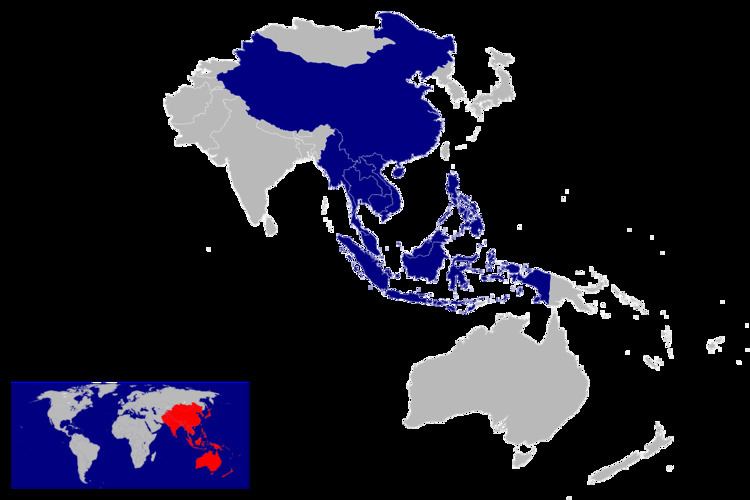Simplified Chinese 中国―东盟自由贸易区 | Traditional Chinese 中國─東盟自由貿易區 | |
 | ||
Hanyu Pinyin IPA [ʈʂʊ́ŋkwǒ tʊ́ŋmə̌ŋ tsɹ̩̂jǒu mâuî tɕʰý] Vietnamese alphabet Khu vực mậu dịch tự do Trung Quốc – ASEAN Indonesian Kawasan Perdagangan Bebas ASEAN-Cina | ||
The ASEAN–China Free Trade Area (ACFTA), also known as China–ASEAN Free Trade Area is a free trade area among the ten member states of the Association of Southeast Asian Nations (ASEAN) and the People's Republic of China. The initial framework agreement was signed on 4 November 2002 in Phnom Penh, Cambodia, with the intention to establish a free trade area among the eleven nations by 2010. The free trade area came into effect on 1 January 2010. The ASEAN–China Free Trade Area is the largest free trade area in terms of population and third largest in terms of nominal GDP.
Contents
Signatories
ASEAN members and the People's Republic of China had a combined nominal gross domestic product of approximately US$6 trillion in 2008. The free trade area had the third largest trade volume after the European Economic Area and the North American Free Trade Area.
ASEAN
Members of ASEAN have a combined population of more than 580 million.
Indonesia accounts for more than 40 percent of the region's population, and its people have voiced the greatest amount of opposition to the agreement. Several days following the implementation of the free trade area, it announced plans to renegotiate tariffs on 228 product categories. In exchange, Indonesia would accelerate implementation of the agreement on 153 categories.
People's Republic of China
China first proposed the idea of a free trade area in November 2000. It had overtaken the United States as the third largest trading partner of ASEAN, after Japan and the European Union, when the free trade area came into effect. Between 2003 and 2008, trade with ASEAN grew from US$59.6 billion to US$192.5 billion. China's transformation into a major economic power in the 21st century has led to an increase of foreign investments in the bamboo network, a network of overseas Chinese businesses operating in the markets of Southeast Asia that share common family and cultural ties. China is also the world's largest exporter.
Framework agreement
Leaders of ASEAN and China, during a meeting in Singapore in November 2000, decided to explore measures aimed at economic integration within the region. In Brunei the following year, they endorsed the establishment of an ASEAN–China Free Trade Area.
The framework agreement was signed on 4 November 2002 in Phnom Penh by eleven heads of government.
Amendments
Amendments for the framework of the free trade area mostly concerned Vietnam. These amendments were designed to assist Vietnam lower tariffs and put forth dates as guidelines.
Upgrade
Negotiations on upgrading the Free Trade Area are expected to conclude in 2015. The upgrade will allow more goods to be traded tariff free and normalize procedures for services, investment, and customs.
Tariffs
The free trade agreement reduced tariffs on 7,881 product categories, or 90 percent of imported goods, to zero. This reduction took effect in China and the six original members of ASEAN: Brunei, Indonesia, Malaysia, the Philippines, Singapore and Thailand. The remaining four countries will follow suit in 2015. The average tariff rate on Chinese goods sold in ASEAN countries decreased from 12.8 to 0.6 percent on 1 January 2010 pending implementation of the free trade area by the remaining ASEAN members. Meanwhile, the average tariff rate on ASEAN goods sold in China decreased from 9.8 to 0.1 percent.
The six original ASEAN members also reduced tariffs on 99.11 percent of goods traded among them to zero.
